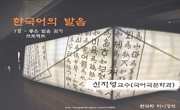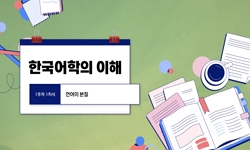This thesis studied the realization patterns of Korean request Speech act. After setting the basic definition and scope of ‘Korean request speech act’, scripts of Korean TV series were gathered and processed as the corpus of the study. This thesis...
http://chineseinput.net/에서 pinyin(병음)방식으로 중국어를 변환할 수 있습니다.
변환된 중국어를 복사하여 사용하시면 됩니다.
- 中文 을 입력하시려면 zhongwen을 입력하시고 space를누르시면됩니다.
- 北京 을 입력하시려면 beijing을 입력하시고 space를 누르시면 됩니다.
부가정보
다국어 초록 (Multilingual Abstract)
Chapter1 at the starting point of the investigation stated the purpose and importance of the topic, and then chose TV series as the data source of this investigation.
Chapter2 set the position of ‘request speech act' among other speech acts in the Korean language mainly following Leech(1983). In this chapter, 5 questions used in Leech(1983) for differentiating speech acts and speech act verbs were borrowed to set the basic system of Korean speech acts, especially to differentiate request speech act from order and suggest.
Chapter3 investigated the realization patterns of Korean speech act on utterance level. When comparing the requests realized as direct speech act with those realized as indirect speech act, it is discovered that overall, direct speech act is preferred. However in cases of asking favors, especially difficult ones, indirect speech act become the preferred form. This chapter also tried to deliver a full description of Korean request speech act system by listing all the forms and main meaning and function of request speech act utterances including those important lexical constituents.
Chapter4 continued the investigation on the discourse level borrowing the notion of Yule(1989)‘s speech act event to see the cooperation between main utterance and assistant utterance. And then within this frame, request strategies were discussed. Finally 4.3 used Grice’ cooperative principle Leech’s politeness to analysis some of the phenomena in Korean request speech acts.
Chapter5 ended the thesis by summarizing the findings made in the chapters above.
This thesis studied the realization patterns of Korean request Speech act. After setting the basic definition and scope of ‘Korean request speech act’, scripts of Korean TV series were gathered and processed as the corpus of the study. This thesis and then discussed the realization patterns of Korean request speech act on utterance level as individual utterances, and on discourse level as speech act event.
Chapter1 at the starting point of the investigation stated the purpose and importance of the topic, and then chose TV series as the data source of this investigation.
Chapter2 set the position of ‘request speech act' among other speech acts in the Korean language mainly following Leech(1983). In this chapter, 5 questions used in Leech(1983) for differentiating speech acts and speech act verbs were borrowed to set the basic system of Korean speech acts, especially to differentiate request speech act from order and suggest.
Chapter3 investigated the realization patterns of Korean speech act on utterance level. When comparing the requests realized as direct speech act with those realized as indirect speech act, it is discovered that overall, direct speech act is preferred. However in cases of asking favors, especially difficult ones, indirect speech act become the preferred form. This chapter also tried to deliver a full description of Korean request speech act system by listing all the forms and main meaning and function of request speech act utterances including those important lexical constituents.
Chapter4 continued the investigation on the discourse level borrowing the notion of Yule(1989)‘s speech act event to see the cooperation between main utterance and assistant utterance. And then within this frame, request strategies were discussed. Finally 4.3 used Grice’ cooperative principle Leech’s politeness to analysis some of the phenomena in Korean request speech acts.
Chapter5 ended the thesis by summarizing the findings made in the chapters above.
국문 초록 (Abstract)
제1장 서론 부분에서는 논의 목적을 설정한 뒤에 화행연구, 그리고 요청화행에 대한 연구의 필요성을 언급을 하였다. 이어서 드라마 자료조사의 방법을 설정했다.
제2장 화행 체계에 있어서 요청화행이 처하는 위치를 논의함으로써, 본 연구에서의 한국어 요청화행의 정의와 범주를 설정하였다. 이 장에서는 주로 Leech(1983)의 분류방법을 따라 5가지의 구별 요인을 설정하여 요청화행의 상하위 범주를 찾았고, 특히 헷갈리기 쉬운 요청과 명령, 요청과 권유를 구별하였다.
제3장에서는 발화의 층위에서 요청화행의 실현양상을 살펴보았다. 우선 3.1절에서는 요청화행을 간접화행과 직접화행으로 양분하여, 한국어 요청화행이 직접화행으로 많이 실현된다는 특징을 발견했다. 3.2에서는 서법별로 요청발화를 살펴보았는데, 요청화행의 요청 대상을 기준으로 5 종류로 분류하였다. 3.3에서는 요청발화에서 특징적으로 나타나는 어휘를 알아보았다. 특히 ‘좀’과 같은 경우에는 거의 요청화행의 담화표지로 되었다는 것을 주목할 만하다.
제4장은 요청화행을 담화의 층위에서 다시 검토를 하였다. 4.1은 Yule(1989)의 요청 사건설을 참고하여 요청의 중심발화와 보조발화의 협동양상을 살펴보았다. 이 절에서는 한국어 요청사건의 3가지 구성을 예문을 통해 설명하였다. 4.2는 전략의 입장에서 요청사건을 분석하였는데, 특히 요청사건에서 보조발화의 중요성을 강조하면서, 보조발화의 주된 유형을 알아보았다. 4.3에서는 Grice(1975)의 대화협력원리와 Leech(1983)의 예의 원리로 요청화행의 실현양상을 설명하였다. 특히 대화협력원리를 위반하는 원인과 이에 대한 해석, 그리고 대화협력원리와 예의 원리가 충돌 될 때 화자의 선택을 주목하고 있다.
제5장은 앞의 논의 내용과 결과를 정리하여 마무리 지었다.
본 논문은 한국어 요청화행의 실현양상에 대한 연구이므로, 요청화행의 정의와 범주를 분명히 한 뒤에, 드라마 자료에서 나타나는 요청화행의 실현양상을 발화 층위와 담화 층위로 나누어...
본 논문은 한국어 요청화행의 실현양상에 대한 연구이므로, 요청화행의 정의와 범주를 분명히 한 뒤에, 드라마 자료에서 나타나는 요청화행의 실현양상을 발화 층위와 담화 층위로 나누어서 논의하였다.
제1장 서론 부분에서는 논의 목적을 설정한 뒤에 화행연구, 그리고 요청화행에 대한 연구의 필요성을 언급을 하였다. 이어서 드라마 자료조사의 방법을 설정했다.
제2장 화행 체계에 있어서 요청화행이 처하는 위치를 논의함으로써, 본 연구에서의 한국어 요청화행의 정의와 범주를 설정하였다. 이 장에서는 주로 Leech(1983)의 분류방법을 따라 5가지의 구별 요인을 설정하여 요청화행의 상하위 범주를 찾았고, 특히 헷갈리기 쉬운 요청과 명령, 요청과 권유를 구별하였다.
제3장에서는 발화의 층위에서 요청화행의 실현양상을 살펴보았다. 우선 3.1절에서는 요청화행을 간접화행과 직접화행으로 양분하여, 한국어 요청화행이 직접화행으로 많이 실현된다는 특징을 발견했다. 3.2에서는 서법별로 요청발화를 살펴보았는데, 요청화행의 요청 대상을 기준으로 5 종류로 분류하였다. 3.3에서는 요청발화에서 특징적으로 나타나는 어휘를 알아보았다. 특히 ‘좀’과 같은 경우에는 거의 요청화행의 담화표지로 되었다는 것을 주목할 만하다.
제4장은 요청화행을 담화의 층위에서 다시 검토를 하였다. 4.1은 Yule(1989)의 요청 사건설을 참고하여 요청의 중심발화와 보조발화의 협동양상을 살펴보았다. 이 절에서는 한국어 요청사건의 3가지 구성을 예문을 통해 설명하였다. 4.2는 전략의 입장에서 요청사건을 분석하였는데, 특히 요청사건에서 보조발화의 중요성을 강조하면서, 보조발화의 주된 유형을 알아보았다. 4.3에서는 Grice(1975)의 대화협력원리와 Leech(1983)의 예의 원리로 요청화행의 실현양상을 설명하였다. 특히 대화협력원리를 위반하는 원인과 이에 대한 해석, 그리고 대화협력원리와 예의 원리가 충돌 될 때 화자의 선택을 주목하고 있다.
제5장은 앞의 논의 내용과 결과를 정리하여 마무리 지었다.
목차 (Table of Contents)
- 제1장 서론 1
- 1.1 연구 목적 및 의의 1
- 1.2 선행 연구 3
- 1.3 연구 방법 9
- 제1장 서론 1
- 1.1 연구 목적 및 의의 1
- 1.2 선행 연구 3
- 1.3 연구 방법 9
- 제2장 화행 체계에서의 요청화행 15
- 2.1 화행이론의 제기와 발전 15
- 2.1.1 화행이론의 제기 15
- 2.1.2 화행론의 확립 17
- 2.1.3 화행이론에 대한 Leech의 비판과 주장 18
- 2.2 화행의 분류방법 및 요청 화행의 지위 21
- 2.2.1 Austin(1962)의 정의와 분류 22
- 2.2.2 Leech(1983)의 분류체계 24
- 2.3 한국어 요청화행의 위치와 정의 28
- 제3장 한국어 요청발화의 실현 양상 31
- 3.1 직접화행과 간접화행으로의 실현 31
- 3.1.1 직접화행과 간접화행의 개념 31
- 3.1.2 요청화행과 직접간접화행 33
- 3.2 요청발화의 문장유형별 실현양상 39
- 3.2.1 명령문으로 실현되는 요청화행 39
- 3.2.2 청유문으로 실현되는 요청화행 43
- 3.2.3 의문문으로 실현되는 요청화행 45
- 3.2.4 평서문으로 실현되는 요청화행 48
- 3.3 요청발화의 어휘적인 실현양상 52
- 3.3.1 감동어와 호격어 53
- 3.3.2 부사 57
- 3.3.3 보조용언 59
- 제4장 한국어 요청 사건의 실현 양상 61
- 4.1 요청 사건과 요청발화 61
- 4.1.2 요청 사건의 실현 양상 66
- 4.2 요청 사건에 나타난 요청 전략 71
- 4.2.1 요청 전략에 관한 연구 71
- 4.2.2 중심발화의 전략 72
- 4.2.3 보조발화의 전략 72
- 4.3 의사소통 원리로 본 요청 사건 76
- 4.3.1 H. P. Grice(1975)의 대화협력원리 76
- 4.3.2 Leech(1980,1983)의 예의 원리 79
- 제5장 결론 84
- 참고문헌 86
- 국문초록 91
- Abstract 93












